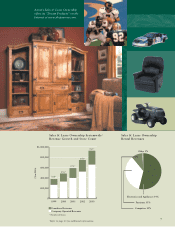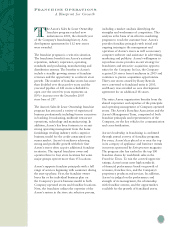Aarons 2003 Annual Report Download - page 19
Download and view the complete annual report
Please find page 19 of the 2003 Aarons annual report below. You can navigate through the pages in the report by either clicking on the pages listed below, or by using the keyword search tool below to find specific information within the annual report.
17
Depreciation of Rental Merchandise. Depreciation of
rental merchandise reflects the expense associated with
depreciating merchandise held for rent and rented to
customers by our Company-operated sales and lease
ownership and rent-to-rent stores.
Critical Accounting
Policies
REVENUE RECOGNITION
Rental revenues are recognized in the month they are due
on the accrual basis of accounting. For internal management
reporting purposes, rental revenues from the sales and lease
ownership division are recognized as revenue in the month
the cash is collected. On a monthly basis, we record an
accrual for rental revenues due but not yet received, net of
allowances, and a deferral of revenue for rental payments
received prior to the month due. Our revenue recognition
accounting policy matches the rental revenue with the
corresponding costs — mainly depreciation — associated with
the rental merchandise. At the years ended December 31,
2003 and 2002, we had a net revenue deferral representing
cash collected in advance of being due or otherwise earned
totaling approximately $12.4 million and $7.5 million,
respectively. Revenues from the sale of residential and
office furniture and other merchandise are recognized
at the time of shipment.
RENTAL MERCHANDISE DEPRECIATION
Our sales and lease ownership division depreciates
merchandise over the agreement period, generally 12 to 24
months when rented, and 36 months when not rented, to
0% salvage value. Prior to 2002, we depreciated sales and
lease ownership merchandise as soon as it was delivered to
our stores from our distribution centers. In the first quarter
of 2002, we began depreciating this merchandise upon
the earlier to occur of its initial lease to a customer or 12
months after it is acquired from the vendor. See Note B to
the Consolidated Financial Statements. Nevertheless, sales
and lease ownership merchandise is generally depreciated at
a faster rate than our rent-to-rent merchandise. As sales and
lease ownership revenues continue to comprise an increasing
percentage of total revenues, we expect rental merchandise
depreciation to increase at a correspondingly faster rate.
Our rent-to-rent division depreciates merchandise over
its estimated useful life, which ranges from six months
to 60 months, net of its salvage value, which ranges from
0% to 60%.
Our policies require weekly rental merchandise counts
by store managers, which includes a write-off for unsalable,
damaged, or missing merchandise inventories. Full physical
inventories are generally taken at our distribution and manu-
facturing facilities on a quarterly basis, and appropriate
provisions are made for missing, damaged and unsalable
merchandise. In addition, we monitor rental merchandise
levels and mix by division, store and distribution center, as
well as the average age of merchandise on hand. If unsalable
rental merchandise cannot be returned to vendors, its carry-
ing value is adjusted to its net realizable value or written off.
All rental merchandise is available for rental and sale. On
a monthly basis, we write off damaged, lost or unsalable
merchandise as identified. These write-offs totaled approxi-
mately $11.9 million, $10.1 million, and $10 million
during the years ended December 31, 2003, 2002, and
2001, respectively.
CLOSED STORE RESERVES
From time to time, we close or consolidate retail stores.
We record an estimate of the future obligation related to
closed stores based upon the present value of the future lease
payments and related commitments, net of estimated sublease
income which we base upon historical experience. At the
years ended December 31, 2003 and 2002, our reserve for
closed stores was $2.2 million and $1.5 million, respectively.
If our estimates related to sublease income are not correct,
our actual liability may be more or less than the liability
recorded at December 31, 2003.
INSURANCE PROGRAMS
Aaron Rents maintains insurance contracts for paying of
workers’ compensation and group health insurance claims.
Using actuarial analysis and projections, we estimate the
liabilities associated with open and incurred but not reported
workers’ compensation claims. This analysis is based upon
an assessment of the likely outcome or historical experience,
net of any stop loss or other supplementary coverages. We
also calculate the projected outstanding plan liability for our
group health insurance program. Our liability for workers’
compensation insurance claims and group health insurance
was approximately $3.8 million and $3.1 million, respec-
tively, at the years ended December 31, 2003 and 2002.
If we resolve existing workers’ compensation claims for
amounts that are in excess of our current estimates and within
policy stop loss limits, we will be required to pay additional
amounts beyond those accrued at December 31, 2003.
Additionally, if the actual group health insurance liability
exceeds our projections, we will be required to pay addi-
tional amounts beyond those accrued at December 31, 2003.
The assumptions and conditions described above reflect
management’s best assumptions and estimates, but these
items involve inherent uncertainties as described above,
which may or may not be controllable by management.
As a result, the accounting for such items could result in
different amounts if management used different assumptions
or if different conditions occur in future periods.
SAME STORE REVENUES
We refer to changes in same store revenues as a key
performance indicator. For the year ended December 31,
2003, we calculated this figure by comparing GAAP revenues
as of December 31, 2003 and 2002 for all stores open for the
entire 24-month period ended December 31, 2003, excluding
stores that received or transferred rental agreements from
other closed or merged stores.
Results of Operations
Year Ended December 31, 2003 Versus Year
Ended December 31, 2002
The following table shows key selected financial data
for the years ended December 31, 2003 and 2002, and the
changes in dollars and as a percentage to 2003 from 2002.
Please refer to this table in conjunction with Management’s
Discussion and Analysis:
























